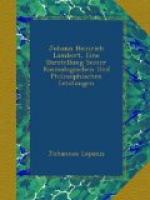|
This section contains 877 words (approx. 3 pages at 300 words per page) |

|
Johann Heinrich Lambert, the German mathematician, physicist, astronomer, and philosopher, was born in Mulhouse, Alsace. He taught himself mathematics, philosophy, and Asian languages; after 1748 he served as tutor in a Swiss family, traveling about Europe with his pupils for several years. He became a member of the Munich Academy in 1759 and of the Berlin Academy in 1764. In 1765 he was appointed by Frederick II as Prussian surveyor of public works. He did research in heat, light, and color and was the founder of the science of photometry. In mathematics Lambert demonstrated that π is an irrational number, and he introduced the conception of hyperbolic functions into trigonometry. In his Kosmologische Briefe über die Einrichtung des Weltbaues (Cosmological letters on the structure of the universe; Augsburg, 1761), Lambert proposed a cosmogonic hypothesis based on Isaac Newton's theory of gravitation; it was similar to the nebular hypothesis...
|
This section contains 877 words (approx. 3 pages at 300 words per page) |

|


